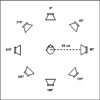Speech perception for adult cochlear implant recipients in a realistic background noise: effectiveness of preprocessing strategies and external options for improving speech recognition in noise
- PMID: 20807480
- PMCID: PMC4127078
- DOI: 10.3766/jaaa.21.7.3
Speech perception for adult cochlear implant recipients in a realistic background noise: effectiveness of preprocessing strategies and external options for improving speech recognition in noise
Abstract
Background: Although cochlear implant patients are achieving increasingly higher levels of performance, speech perception in noise continues to be problematic. The newest generations of implant speech processors are equipped with preprocessing and/or external accessories that are purported to improve listening in noise. Most speech perception measures in the clinical setting, however, do not provide a close approximation to real-world listening environments.
Purpose: To assess speech perception for adult cochlear implant recipients in the presence of a realistic restaurant simulation generated by an eight-loudspeaker (R-SPACE) array in order to determine whether commercially available preprocessing strategies and/or external accessories yield improved sentence recognition in noise.
Research design: Single-subject, repeated-measures design with two groups of participants: Advanced Bionics and Cochlear Corporation recipients.
Study sample: Thirty-four subjects, ranging in age from 18 to 90 yr (mean 54.5 yr), participated in this prospective study. Fourteen subjects were Advanced Bionics recipients, and 20 subjects were Cochlear Corporation recipients.
Intervention: Speech reception thresholds (SRTs) in semidiffuse restaurant noise originating from an eight-loudspeaker array were assessed with the subjects' preferred listening programs as well as with the addition of either Beam preprocessing (Cochlear Corporation) or the T-Mic accessory option (Advanced Bionics).
Data collection and analysis: In Experiment 1, adaptive SRTs with the Hearing in Noise Test sentences were obtained for all 34 subjects. For Cochlear Corporation recipients, SRTs were obtained with their preferred everyday listening program as well as with the addition of Focus preprocessing. For Advanced Bionics recipients, SRTs were obtained with the integrated behind-the-ear (BTE) mic as well as with the T-Mic. Statistical analysis using a repeated-measures analysis of variance (ANOVA) evaluated the effects of the preprocessing strategy or external accessory in reducing the SRT in noise. In addition, a standard t-test was run to evaluate effectiveness across manufacturer for improving the SRT in noise. In Experiment 2, 16 of the 20 Cochlear Corporation subjects were reassessed obtaining an SRT in noise using the manufacturer-suggested "Everyday," "Noise," and "Focus" preprocessing strategies. A repeated-measures ANOVA was employed to assess the effects of preprocessing.
Results: The primary findings were (i) both Noise and Focus preprocessing strategies (Cochlear Corporation) significantly improved the SRT in noise as compared to Everyday preprocessing, (ii) the T-Mic accessory option (Advanced Bionics) significantly improved the SRT as compared to the BTE mic, and (iii) Focus preprocessing and the T-Mic resulted in similar degrees of improvement that were not found to be significantly different from one another.
Conclusion: Options available in current cochlear implant sound processors are able to significantly improve speech understanding in a realistic, semidiffuse noise with both Cochlear Corporation and Advanced Bionics systems. For Cochlear Corporation recipients, Focus preprocessing yields the best speech-recognition performance in a complex listening environment; however, it is recommended that Noise preprocessing be used as the new default for everyday listening environments to avoid the need for switching programs throughout the day. For Advanced Bionics recipients, the T-Mic offers significantly improved performance in noise and is recommended for everyday use in all listening environments.
American Academy of Audiology.
Figures




Similar articles
-
Improving speech perception in noise for children with cochlear implants.J Am Acad Audiol. 2011 Oct;22(9):623-632. doi: 10.3766/jaaa.22.9.7. J Am Acad Audiol. 2011. PMID: 22192607
-
Evaluation of speech recognition in noise with cochlear implants and dynamic FM.J Am Acad Audiol. 2009 Jul-Aug;20(7):409-21. doi: 10.3766/jaaa.20.7.3. J Am Acad Audiol. 2009. PMID: 19928395 Clinical Trial.
-
Cochlear implant microphone location affects speech recognition in diffuse noise.J Am Acad Audiol. 2015 Jan;26(1):51-8; quiz 109-10. doi: 10.3766/jaaa.26.1.6. J Am Acad Audiol. 2015. PMID: 25597460 Free PMC article.
-
Is there evidence for the added value and correct use of manual and automatically switching multimemory hearing devices? A scoping review.Int J Audiol. 2018 Mar;57(3):176-183. doi: 10.1080/14992027.2017.1385864. Epub 2017 Oct 10. Int J Audiol. 2018. PMID: 29017358
-
The development of the Nucleus Freedom Cochlear implant system.Trends Amplif. 2006 Dec;10(4):175-200. doi: 10.1177/1084713806296386. Trends Amplif. 2006. PMID: 17172547 Free PMC article. Review.
Cited by
-
Speech understanding in diffuse steady noise in typically hearing and hard of hearing listeners.PLoS One. 2022 Sep 14;17(9):e0274435. doi: 10.1371/journal.pone.0274435. eCollection 2022. PLoS One. 2022. PMID: 36103551 Free PMC article.
-
N-Myc and L-Myc are essential for hair cell formation but not maintenance.Brain Res. 2012 Nov 12;1484:1-14. doi: 10.1016/j.brainres.2012.09.027. Epub 2012 Sep 25. Brain Res. 2012. PMID: 23022312 Free PMC article.
-
The Effects of Preprocessing Strategies for Pediatric Cochlear Implant Recipients.J Am Acad Audiol. 2016 Feb;27(2):85-102. doi: 10.3766/jaaa.14058. J Am Acad Audiol. 2016. PMID: 26905529 Free PMC article.
-
The Role of Autosensitivity Control (ASC) in Cochlear Implant Recipients.Audiol Res. 2021 Jan 21;11(1):22-30. doi: 10.3390/audiolres11010003. Audiol Res. 2021. PMID: 33494464 Free PMC article.
-
Beamforming and Single-Microphone Noise Reduction: Effects on Signal-to-Noise Ratio and Speech Recognition of Bimodal Cochlear Implant Users.Trends Hear. 2022 Jan-Dec;26:23312165221112762. doi: 10.1177/23312165221112762. Trends Hear. 2022. PMID: 35862265 Free PMC article.
References
-
- Balkany T, Hodges A, Menapace C, et al. Nucleus Freedom North American clinical trial. Otolaryngol Head Neck Surg. 2007;136:757–762. - PubMed
-
- Blamey PJ, Martin LFA, Fiket HJ. A digital processing strategy to optimize hearing aid outputs directly. J Am Acad Audiol. 2004;15:716–728. - PubMed
-
- Compton-Conley CL, Neuman AC, Killion MC, Levitt H. Performance of directional microphones for hearing aids: real-world versus simulation. J Am Acad Audiol. 2004;15:440–455. - PubMed
-
- Dawson PW, Decker JA, Psarros CE. Optimizing dynamic range in children using the Nucleus cochlear implant. Ear Hear. 2004;25:230–241. - PubMed
Publication types
MeSH terms
Grants and funding
LinkOut - more resources
Full Text Sources
Medical
